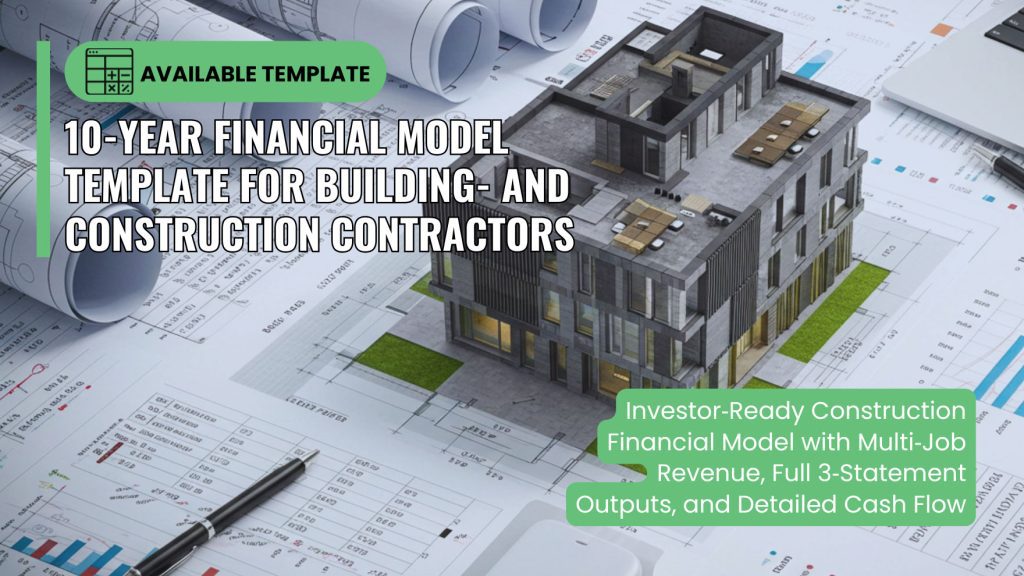
This 10-Year Construction Financial Model Excel Template equips building contractors, developers, and startup construction companies with a comprehensive toolkit for financial forecasting, valuation, and funding readiness. It delivers dynamic 10-year construction financial projections supported by full three-statement financials.
Designed for bank loans, investor decks, business planning, and internal strategy, the model ensures transparency, credibility, and precision across South Africa, Africa, and international markets.
Plan, fund, and scale with confidence. The Best Financial Models Construction Financial Model in Excel converts operational data into forward-looking construction project cash-flow forecasts, integrating multi-project revenue, CAPEX, debt, and equity to produce banker-friendly outputs—P&L, Balance Sheet, and Cash Flow—plus IRR, DSCR, and a DCF-based valuation summary.
Built in Excel, the construction financial model template features fully connected statements and configurable inputs for up to three project types. Users can model job timelines, pricing, material costs, and workforce scaling to test financial projections for construction companies of all sizes. It also includes assumptions for equipment purchases, rentals, overheads, and funding sources, ensuring an accurate view of startup and operational costs.
Configure residential builds, commercial fit-outs, and infrastructure projects using flexible input drivers. The model transforms those assumptions into an auditable construction cash flow forecast, a complete valuation model, and a detailed IRR waterfall that allocates proceeds among investors and founders.
Whether you’re scaling a construction business, managing multiple sites, or preparing an exit strategy, this construction financial model provides investor-grade analytics and bank-ready outputs. Its flexibility, depth, and accuracy make it essential for feasibility studies, fundraising, and long-term strategic planning.
| Component | Description |
| Dashboard (Executive Summary) | One‑page KPIs, profitability, liquidity, leverage, and returns. |
| Graphs | Charts across revenue, margins, cash, leverage, and valuation. |
| Main Project Assumptions | WACC, inflation, payment terms, tax, cash sources, and debt settings. |
| Revenue Assumptions | Up to 3 job categories with monthly job starts, pricing, and utilisation. |
| Construction Cost Assumptions | Materials, equipment rental, subcontractors per category. |
| OPEX Assumptions | Fixed running costs (monthly values by year) with escalation. |
| CAPEX Assumptions | Asset schedules with life, depreciation, disposals, and write‑offs. |
| Debt Assumptions (Schedule) | Borrowings, interest, repayments, and balances are ready for lender review. |
| Startup Costs Assumptions | One‑off pre‑operations items are kept separate from OPEX/CAPEX. |
| P&L / BS / CF — Monthly and Annual | Linked 3‑statement reporting. |
| Control Sheets (Monthly and Annual) | Auditable line‑by‑line construction to GP, net profit, and cash. |
| High‑Level Valuation | DCF valuation model with terminal value and allocation of exit proceeds. |
The use of this financial model is solely at the user’s own risk. Best Financial Models provides the template as a tool to assist users in their business planning and decision-making processes. However, the responsibility for adhering to the model’s instructions and guidelines lies entirely with the user. Best Financial Models cannot and will not be held liable for any inaccuracies, errors, or unintended outcomes resulting from the user deviating from the prescribed usage, including but not limited to the deletion, addition, or modification of rows, columns, formulas, or any other components of the model. Users are strongly advised to exercise caution when making any changes to the model to ensure its integrity and reliability are maintained.
| Business Type | Construction |
|---|---|
| File Format | Microsoft Excel |
An Excel construction financial model is a structured forecasting tool that helps developers and contractors assess profitability, cash flows, and funding requirements throughout the project lifecycle. The BFM Construction Financial Model Excel offers a 10-year forecast with automated IRR, NPV, DSCR, and payback calculations.
It links detailed CAPEX and OPEX schedules to revenue assumptions and financing ratios, providing investors with a comprehensive view of project bankability. Because it aligns with professional project finance standards, this model enables users to present accurate, credible financial projections to lenders and partners—turning complex construction data into a single, investor-ready dashboard.
The BFM Construction Financial Model template includes fully integrated income statements, balance sheets, and 10-year cash flow forecasts. It automatically consolidates assumptions on project timing, progress payments, and cost phasing to generate complete financial projections for construction companies.
Users can toggle between base, downside, and upside cases to test resilience under different financing and cost scenarios. Each module—revenues, costs, debt, and equity—feeds into clear KPIs such as IRR, NPV, and DSCR. Built in Excel, the model is fully editable and ideal for feasibility studies, funding submissions, and strategic project budgeting.
The construction project cash flow forecast module in the BFM Construction Financial Model Excel model sequences all inflows and outflows across the construction timeline. CAPEX, retention, and financing drawdowns are automatically linked to project milestones.
Users can monitor liquidity positions month-by-month, detect periods of negative cash, and adjust funding ratios or schedule curves to maintain solvency. The tool also calculates DSCR and LLCR, so banks can test debt service capacity. With clear charts showing cumulative and net cash flow, the model helps developers manage cash risk and structure project financing that matches the construction schedule.
The BFM Construction Financial Model Excel is flexible enough for both small contractors and multi-project developers. You can adjust project scale, cost categories, and duration without breaking links or formulas. Each sheet is clearly labelled—Inputs, Calculations, Outputs—so even first-time users can confidently build 10-year construction project forecasts.
Larger companies can combine multiple projects to test portfolio performance or group cash positions. Because it is Excel-based, the template integrates easily with accounting systems, allowing SMEs and corporates alike to produce lender-grade financial models that track performance and profitability across every project.
The construction financial model Excel automatically generates IRR, NPV, payback period, DSCR, LLCR, and profitability ratios that lenders and investors require. It also tracks cost per square metre, gross margin, and gearing levels over 10 years. The BFM Construction Financial Model includes built-in dashboards that show year-on-year revenue, expenses, and cash flow movements for instant visual review.
Users can test cost overruns, delays, and funding changes through sensitivity tables. These indicators allow developers, contractors, and financiers to evaluate whether a project meets internal and external return thresholds before committing capital.
The construction project finance model template demonstrates a project’s financial viability to banks, DFIs, and investors. It shows how construction costs, equity, and debt combine to achieve acceptable DSCR and IRR levels. The BFM Construction Financial Model Excel produces lender-friendly outputs, including cash flow waterfalls, covenant tests, and repayment schedules.
By quantifying credit metrics and equity returns, it streamlines funding discussions and shortens due diligence time. Investors see transparent assumptions, while financiers can stress-test coverage ratios and repayment profiles. This makes the BFM template a trusted foundation for professional project-finance negotiations.
Yes. The BFM Construction Financial Model Excel is completely editable, with unlocked formulas and structured input sheets. You can rename accounts, modify cost categories, and insert company-specific reporting lines. This flexibility allows contractors to integrate the model with their internal budgeting tools or accounting systems.
Whether adjusting tax rates, inflation, or project duration, every change automatically updates the 10-year financial projections for construction companies. Because it’s formula-driven rather than macro-locked, finance teams can audit or extend it easily—ideal for analysts and project managers who value transparency and control.
The construction financial model runs detailed 10-year projections, covering design, build, and post-construction operations. The period can be shortened for short-term contracts or extended for multi-phase developments. Within the BFM Construction Financial Model Excel, users can model refinancing, residual values, or asset sales at the end of each phase.
Long-term forecasting reveals how working capital, debt repayment, and profit margins evolve. This holistic perspective enables both contractors and financiers to assess sustainability beyond project completion, thereby improving planning and risk management.
The construction financial model template links each cost input to the project schedule, automatically generating monthly construction project cash flow forecasts and variance reports. It helps finance teams compare planned versus actual expenditures and flag overruns early.
The BFM Construction Financial Model Excel highlights cost sensitivities—materials, labour, financing—and their effect on project profit and liquidity. Its dashboards visualise cost drivers and performance ratios, giving management an early warning system. By aligning budgeting and forecasting in one workbook, the template promotes accountability and financial discipline across all construction phases.
The Best Financial Models Construction Financial Model Excel delivers professional-grade project finance capabilities in a user-friendly format. It combines editable assumptions, 10-year forecasts, IRR/NPV dashboards, DSCR/LLCR tests, and scenario analysis within a single Excel workbook. Developed by construction finance experts, the template is already formatted for lender and investor presentations.
Users save weeks of modelling time while gaining accuracy and credibility. Whether you’re bidding on a project, raising finance, or evaluating feasibility, this BFM template is the authoritative resource for construction financial modelling across South Africa, Africa, and global markets.
This dynamic workbook forecasts project cash flows, cost curves, and profit margins. It automates balance sheet, income, and cash-flow projections—making it ideal for funding applications, bid models, and strategic planning.
This comprehensive 10-Year Construction Financial Model Excel Template, with integrated 3-statement financials, CAPEX and OPEX schedules, dashboards, and scenario analysis, is specifically built for contractors, developers, construction companies, and project financiers.
Build better, forecast smarter, and secure funding with this construction financial model. Use this fully editable Excel design with no hidden formulas or macros to produce comprehensive forecasts, complete cash flow schedules, and profitability metrics.
The template automatically calculates IRR, NPV, funding adequacy, and project returns—making it ideal for financial projections for construction companies seeking bank-ready and investor-ready outputs.
This construction financial model is perfect if you are building your contractor business plan, construction business plan, or building business plan.
R3,999.00
We accept various methods of payment, including Visa, Mastercard, and EFT.
Our site is secured with SSL certification and we do not store any of your payment details.
Immediate access to your chosen financial model, compatible with Excel or Google Sheets.
Our templates are designed for global use, featuring support for all major currencies.
Need an investor-ready Business Plan, Market Research, Feasibility Study, or Investor Deck for your construction venture? Explore the JTB Consulting Construction Business Plan and Feasibility Study services — bespoke strategic planning, bank‑ready models, and investor narratives since 2006.
We don’t spam, and you can always opt out at any time.
